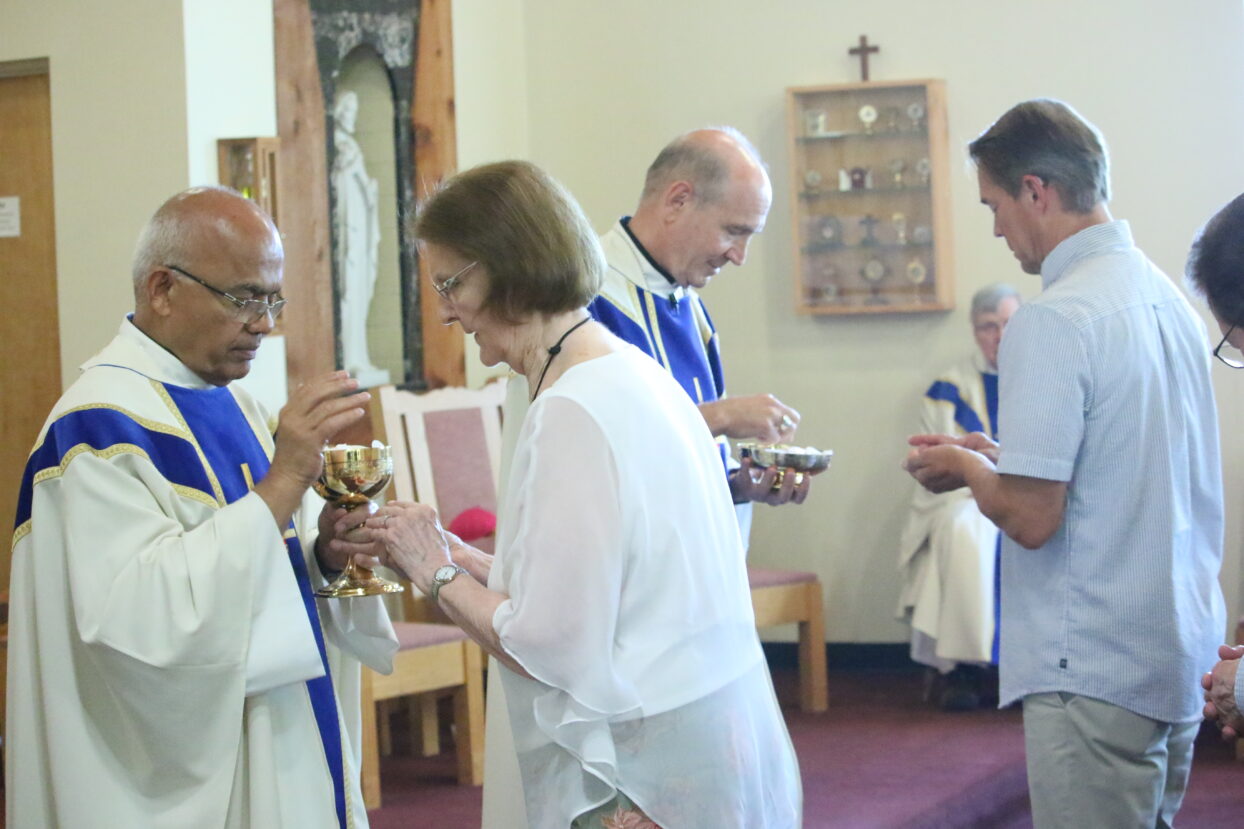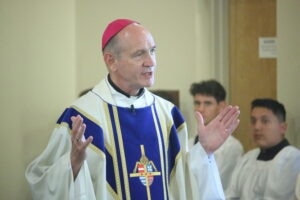Notre Dame Parish in Greeneville celebrates its 70th anniversary as an overflow crowd attends
By Dan McWilliams
Founding parishioner Judy Miniat Collins has served in many leadership roles at Notre Dame in Greeneville, and upon the community’s 70th-anniversary celebration on April 27 she reflected on a recent occasion when the parish she has given so much to gave back to her.
“It’s the most caring, faithful, giving community I’ve witnessed,” said the 81-year-old, the lone remaining member from Notre Dame’s founding in 1955. “I was part of the giving part for many, many years. And this past year, my son became totally bedridden, and when we came home from the hospital after three years, for one month the church community came to our house and fed us, and I got to be the receiver. That was very humbling, but I understood from what I had done in the past where they were coming from because I had been on the other side.”
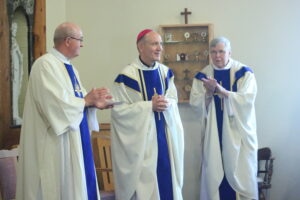
After Father Kuzhupil thanked him for visiting Notre Dame, Bishop Mark Beckman received a round of applause from everyone gathered, including Deacon Wil Johnson (left) and former Notre Dame pastor Father Dan Whitman. (Photo Dan McWilliams)
Bishop Mark Beckman joined Notre Dame pastor Father Joseph Kuzhupil, MSFS, and former pastor Father Dan Whitman for a 70th-anniversary Mass on Divine Mercy Sunday that was attended by some 235 of the faithful. All 160 seats in the nave were filled along with about 75 more in an overflow area. The celebration continued after Mass with a dinner and dance at the Eastview Recreation Center near the church.
Father Kuzhupil welcomed the large gathering to the anniversary Mass.
“It marks a joy to celebrate this 70th anniversary of the dedication of this church, where we experience the Lord of Divine Mercy through the Eucharist, through the sacrament of reconciliation, all the sacraments that are celebrated here that offer God’s mercy to us,” he said. “It enhances our joy to welcome our Bishop Beckman, and he is making his first visit to Notre Dame and Greeneville,” a remark that drew a round of applause.
Father Kuzhupil also welcomed Father Whitman, pastor from 2014 to 2019, and master of ceremonies Deacon Hicks Armor.
The bishop then expressed his gratitude to the pastor.
“Father Joseph, thank you for that very warm and gracious welcome, and it is a great joy to be with you today,” Bishop Beckman said. “One of my great joys so far n being bishop of the Diocese of Knoxville has been the opportunity to visit our churches, these communities of living faith, and to be with you this afternoon is a true gift for me, especially as you mark 70 years as a parish community. What a joy.”
‘A holy place of encounter with the risen Lord’
Bishop Beckman began his homily talking about Divine Mercy Sunday.
“If I am not mistaken, Pope John Paul II, now St. John Paul II, for his first encyclical letter wrote about the Father of Mercy, and it was he who inaugurated the name for this octave of Easter as a Sunday of Divine Mercy,” he said. “And so today we gather here in this church to celebrate the fullness of the mystery of the resurrection, the great mercy of God that is poured out on the world through the gift of His Son on the cross.”
“Now, who of us needs the mercy of God?” the bishop added, producing laughter and nods of approval. “All of us need the mercy of God, don’t we? All of us need mercy in life.”
The day’s Gospel came from John 20:19-31.
“And the risen Lord Jesus in the Gospel this evening knows that the Apostles are trapped in fear and trapped in shame and guilt,” the bishop said. “They had abandoned Him on Good Friday when He needed them most, and yet the locked door of their fear and shame does not prevent the risen Lord from becoming present to them. And the first words are ‘peace be with you,’ not ‘where were you,’ not ‘why did you fail me,’ ‘why did you run away’—none of that. ‘Peace be with you, as the Father has sent me, so now I will send you,’ and He breathed on them the gift of the Holy Spirit.
“That is the mercy of God, so tender that He even says to Thomas one week later, ‘Thomas, do not be afraid to touch my wounds. Those wounds are what healed you, Thomas,’ and Thomas understands, doesn’t he? ‘My Lord and my God,’ he proclaims.”
Bishop Beckman then spoke of the parish’s anniversary.
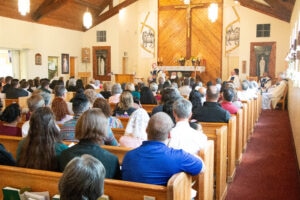
All 160 spots were taken in the pews plus some 75 more in an overflow area at Notre Dame for the anniversary Mass. (Photo Bill Brewer)
“This Church of Notre Dame for 70 years has been a holy place of encounter with the risen Lord, a place of encounter with His mercy,” he said. “Every time you gather in this place to celebrate the Eucharist, the body of the risen Lord Jesus becomes a healing remedy for you, food for your journey. The risen Lord tonight is as close to us as He was to the Apostles in the Upper Room. He sang to us tonight, ‘Peace be with you.’”
The special moments that have taken place in the Greeneville church over 70 years may be innumerable.
“Father Joseph referred to it, but think of how many little babies have been baptized in this church, and adults. How many confirmations? How many first Communions? How many moments when we have celebrated Christmas here and Easter?” Bishop Beckman said. “The sacrament of reconciliation, receiving the mercy of God over and over again. That’s what is so beautiful, and if we have received that kind of mercy in this place, then the Lord wants us to go out into the world and offer mercy to our brothers and sisters, so that we can say to them in their moment of need, ‘Peace be with you.’”
The bishop continued on the theme of peace and mercy, even with a baby in the pews crying quite loudly.
“We bring the peace of the Lord Jesus with us as we go forth from this place,” he said. “May the Lord bless this community with many more decades of encounters with the mercy of the risen Lord, and may that mercy touch all of us, even that little child. That’s a sign of the living church, forming the next generation; it’s so good to have those voices here tonight.”
In his closing remarks at Mass, Bishop Beckman referred to a display executed in wood depicting Notre Dame Church that was in the narthex. The bishop blessed the artwork before the Mass. Charlie Cronin and his team of Jim Williams and John Seehoffer created the work. The wood came from a large tree on the property that had to be taken down, and Mr. Williams kept a piece of the trunk after the tree was removed. “I want to take a moment to thank you all for your presence here today. What a huge community this is. I see why you all need a new church building,” the bishop said. “I know that our Spanish brothers and sisters, you did not have your Mass today at 3, so thank you for being here today. I do not speak a lot of Spanish. Yo hablo poquito español,” he added, which drew applause.
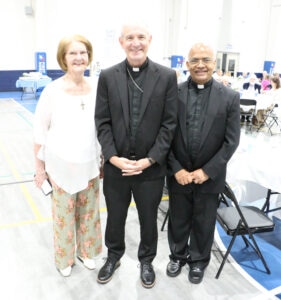
Founding parishioner Judy Miniat Collins poses for a photo with Bishop Mark Beckman and Father Joseph Kuzhupil, MSFS, at the dinner following the 70th-anniversary Mass at Notre Dame Church in Greeneville. (Photo Bill Brewer)
Reflections after Mass
Father Kuzhupil said the anniversary celebration came two days after the date in 1955 when the church was dedicated.
“It’s a great joy for all of us. We’ve been looking forward to this day,” he said. “It fell on Divine Mercy Sunday, and Friday was the actual anniversary of the dedication of the church, on the feast of Our Lady of Good Counsel, who is the patroness of our parish.”
The Notre Dame pastor said his parish has about 550 families now. Attendance is about 500-600 combined at four Masses on a typical weekend.
“It is a growing parish,” he remarked.
Bishop Beckman also saw the fact that the church is literally bursting at the seams.
“It was packed. I see why they need a new church here,” he said. “They’re talking about building a new church, and they have some preliminary plans, and I’m looking forward to seeing the future as it unfolds here at this beautiful community.”
Having the celebration on Divine Mercy Sunday made for a “beautiful, perfect day,” Bishop Beckman said.
“The gift of Easter is the gift of mercy. The risen Lord brings mercy, forgiveness, and healing to all of us,” he said.
Fred Ricker, director of music at Notre Dame, attended the anniversary Mass with wife Wanda. Both are converts and longtime parishioners of Notre Dame.
“I think it’s real nice, and it’s great to celebrate,” said Mr. Ricker, who was wearing a shirt from the 50th anniversary of the parish.
Elaine Janaskie, chair of family life on the Notre Dame parish pastoral council, was in charge of the dinner. A dance followed the dinner with country music provided by The Flying J’s.
The planning took “a good year, a lot of work, a lot of help, and a lot of people doing things behind the scenes to make it happen,” Mrs. Janaskie said, adding that the “whole church” volunteered.
The event was “really wonderful, better than what I thought it would be,” she added.
A history of Notre Dame Parish
Greeneville Catholics first worshiped at St. Patrick Church, a 28-by-40-foot building on College Street, from 1870 until 1949, with Irish railroad workers and their families forming the bulk of early parishioners. Circuit-riding priest Father Emmanuel Callahan, based out of Immaculate Conception Parish in Knoxville, oversaw mission parishes in 34 counties of East Tennessee, including St. Patrick, from 1899 to 1916. The Dominican Fathers, based at St. Mary in Johnson City, eventually began caring for Catholics in Greeneville.
The St. Patrick building was reported to be in poor condition as early as 1922, and though repairs were made, five years later a census showed there were only a family of 10, a widow, and one other couple remaining in the parish. The Dominicans undertook another set of repairs to the church in 1937. During this era, knowing that St. Patrick was unheated, Capitol Theater manager Harry Beekner offered the balcony of the Greeneville movie house for the celebration of Mass in the winter.
By 1949, the St. Patrick building was deemed beyond repair, and by November of that year Bishop William L. Adrian of Nashville accepted an offer from the Intermountain Telephone Co. for $7,000 for the building and its half-acre plot of land. In 1950, St. Patrick Church was demolished.
The search for new land launched as Masses continued to be held in the theater. In March 1954, the land was located: a 6.72-acre site that was the old Davenport farm, purchased for $11,760.
Meanwhile, the Magnavox electronics company of Fort Wayne, Ind., had opened the Greeneville Cabinet Co. in 1947. Magnavox was a large employer in the city and had a presence in Greeneville until 2005, also producing the last American-made TV there. Vice president and later president of the company, Frank Freimann, a Catholic, offered jobs to his fellow Hoosiers in the 1940s, but they wanted a Catholic church in Greeneville before moving there. Magnavox contributed funds toward the purchase of the land where the new church was built.
That church, a cruciform building in a modified colonial style, was completed in 1955. The St. Patrick name had gone to the new parish in Morristown that was forming at about the same time, so Bishop Adrian named the Greeneville parish Notre Dame. The church also featured a 60-foot bell tower. Mr. Freimann gave the new building a black Italian marble altar, the two alcoves to its right and left, and the black marble crucifix that is now in the narthex. When he died in 1968, he gave a further gift of $20,000 to Notre Dame.
The dedication took place at a 5 p.m. Mass on Monday, April 25, 1955, with Bishop Adrian presiding and eight priests participating.
Over the years, the rectory was completed in 1965, a bell installed in the tower in 1974, a parish hall added in 1976, a church pavilion finished in 1986, and the Ganz House now used for youth activities purchased in 1988. Under the pastorate of Father John Appiah, ground was broken for an education wing completed in 2010.
The Council of Catholic Women at the parish traces its roots to the Altar and Rosary Society of the old St. Patrick Parish. Notre Dame also is home to many guilds, and its Knights of Columbus Council 6784 was chartered in 1976. Hispanic ministry began in earnest with the arrival of associate pastor Father Joseph Hammond, CHS, in 1998 and continues today with Father Andres Cano and Sister Maria Esther Ordoñez Cuevas, MAG. An adoration chapel was added in 2023.
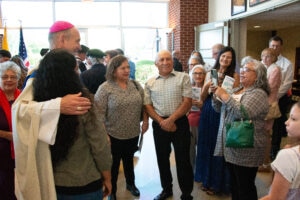
Bishop Beckman greeted many parishioners of Notre Dame after Mass and posed for a number of photos with them. (Photo Bill Brewer)
Longtime parishioners look back
Susan Collins, director of religious education and youth ministry for Notre Dame, came to the parish when she was in third grade, made her confirmation there, and has worked for Notre Dame for more than two decades.
The 70th-anniversary celebration “is very important to the parish … Planning this, there has been a big team effort,” Mrs. Collins said.
Attendance at the anniversary Mass showed the limited capacity of Notre Dame and the need for a new church, she added.
Mrs. Collins is the mother of Father Dustin Collins, pastor of St. Mary Parish in Johnson City. Being the mom of a priest allowed her to experience a special moment when Father Collins came to Notre Dame, his home parish, the day after his priestly ordination in 2012.
“My son and my daughter were baptized here, made their first Holy Communion, and received their confirmation. My son was ordained at the cathedral, but his first Mass was here,” Mrs. Collins said. “Learning the tradition of when a priest is ordained and they bless his hands with the sacred chrism, and then he wipes them off—when he had the first Mass, he called his father and I up, and he presented a box to his dad that had a stole in it from when he heard his first confession, and then he called me up, and he gave me the cloth that they wiped his hands off on, and one of our parishioners had embroidered his name and the date. Then he said that upon my death it will be put in my hands so Mary will know I’m the mother of a priest. Well, there wasn’t a dry eye in the place after that.”
Sharon Folk of Notre Dame is among the longtime parishioners of the Greene County parish. She chairs the Diocese of Knoxville’s Finance Council and has been a member of the panel for 27 years. She also chairs the Notre Dame parish finance council and has been a member of that body for 15 years. She is also a Dame of the Grand Cross with the Equestrian Order of the Holy Sepulchre of Jerusalem.
“I’m a convert. I converted 60 years ago. We lived here, and so I became a member. May 1 will be 60 years,” Ms. Folk said.
She recalled the priest from her childhood, Father Bernard Niedergeses, who was Notre Dame pastor from 1956 to 1966.
“It was very small. We had one Mass at 9 a.m. on Sunday morning, and the priest had to serve Rogersville, Newport, and Greeneville,” she said.
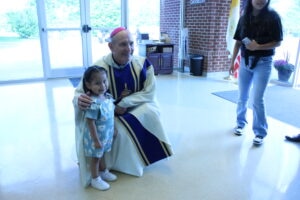
Bishop Beckman kneels down for a photo with one of Notre Dame’s youngest parishioners. (Photo Dan McWilliams)
The 70th-anniversary Mass may not have had as many people attending as did another recent liturgy, Ms. Folk said.
“On Ash Wednesday, we had 296 people, and the sanctuary holds 160, and the 11 and the 3 are bursting at the seams. There’s still room at the 8 a.m. on Sunday and the 5 p.m. on Saturday,” she said, adding that “it’s a wonderful problem to have.”
Judy Collins, a distant relative of Susan Collins, has memories going back to the days before Notre Dame was established.
“My father was working for Magnavox, and he would not move to Greeneville until there was a Catholic church. He was flying back and forth for two years from Fort Wayne, Ind.,” she said. “They had a church service in the mezzanine of the Capitol Theater. Charles Alter, who died a few years ago, who was an original member of the church, it was his grandfather’s theater, and we went to Mass there.”
With the Notre Dame dedication set for the following spring, Mrs. Collins’ father brought the family to Greeneville in fall 1954.
“My dad knew the church was going to open up in April, but he brought us in the fall so we could start school and be there through the year,” she said. “When the church opened up, it was really, really special. I think there were like 10 families, and when we had religious education, which we had on Saturday, the priest would drive to Newport, to Rogersville, to someplace up in the mountains, and he would bring all the kids from all those places, and we had class together. I was like in the sixth grade then, and there were some who were smaller and some who were bigger.”
Father Siener arrived in 1950 as the St. Patrick days ended, and he remained to become the founding pastor of Notre Dame before he left in 1956.
“I made my confirmation at Notre Dame. Father Albert Siener—he was the first priest who was here. He also did magic acts. He’d take a quarter out of your ear. He played golf, too,” Mrs. Collins remembered. “He didn’t have a rectory, so he lived at the Round Table Restaurant Hotel. He had like a little apartment down below, and that’s where he lived. It was close to the church.”
Mrs. Collins saw Notre Dame grow over the years as it became a Diocese of Knoxville parish. Her family attended the Mass in 1988 in which the diocese was erected and Bishop Anthony J. O’Connell installed as its first shepherd.
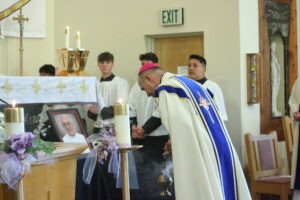
Bishop Beckman bows after incensing the altar at Notre Dame Church before the anniversary Mass. A photo of Pope Francis, who died six days before the Mass, stands in front of the altar. (Photo Dan McWilliams)
“We went down when the bishop was installed, and my mother sat on the front row with the priests,” Mrs. Collins said. “She was like my age, and she didn’t have a seat and couldn’t see, so she went and stood, and one of priests got up and said, ‘Ma’am, come sit right here,’ so she sat in the front row when the first bishop of our diocese was ordained.”
Notre Dame Church, in Mrs. Collins’ youth, did not have the classroom space that it does now in the Ganz House that is part of the property.
“When we had classes, we didn’t have rooms,” she said. “One class would meet like in the front pew, another class in the choir loft, another class in the cry room—we used to have a cry room. We had different places all throughout the church.”
The church at that time did not have a rectory. That building would be completed in 1965 in Father Niedergeses’ final year as pastor.
“When the church opened, the priest got to move into the church. His bedroom was behind the altar—it was about 8 by 10—it was really little,” Mrs. Collins recalled. “What now is the adoration chapel was the office and living room. He had a bathroom back there, and that was it. He used the kitchen that was in a little bitty church hall, not very big at all. That’s where he lived until a rectory was built.”
The Notre Dame pastors served more than just the Greeneville parish in those days.
“For many, many years, our priests had Mass in Rogersville and Sneedville together, Mass in Newport, and Mass in Greeneville, all three on Sunday, so he was really spread thin. It was really hard,” Mrs. Collins said. “Now they have churches in all those places.”
The Magnavox presence and other industry that resulted in people moving to Greeneville helped the parish grow, she remembered.
“They had meatless Fridays in the cafeterias in the school system, and there weren’t any Catholic kids except for about 10 of us, two families,” she said.
A local publication apparently wasn’t at first welcoming to the Catholic community.
“In the newspaper on the weekends, they would list all the churches, and it was like 300 churches in our county, a lot, mostly Baptist,” Mrs. Collins said. “They’d have the Baptist churches, the Episcopalian churches, the Lutheran churches, the Presbyterian churches, and then there would be a category ‘other,’ and we were ‘other.’ The newspaper was not kind to us at the beginning, but our community has been involved with the local community, giving to the community, and they found out that we weren’t awful people, that we were OK.”
Mrs. Collins now teaches RCIA at Notre Dame but is a retired schoolteacher who “taught everything” for 34 years at Camp Creek, DeBusk, West Pines, and Mosheim elementary schools in the county.
“Before I retired, this one lady was a really good cook, so she made the cakes and pies and everything so I could take them to my RCIA classes every Tuesday evening, and I said, ‘You realize this food is going to making Catholics,’ and she said, ‘That’s OK, Judy,’” Mrs. Collins recalled.
Father Wiatt Funk, pastor of Notre Dame from 1976 to 1984, was a victim of a prank by an adult Mrs. Collins and her friend, after he played the Barbara Mandrell song “Crackers.”
“He was a wonderful musician, and he loved dogs. We had a social in our church hall, and he was playing the song, ‘You can eat crackers in my bed anytime, baby,’” Mrs. Collins said. “I and another evil person went to the rectory, and we got crackers and crumbled them up, and we short-sheeted the bed and put crackers in there. The next day at church, he knew who did it. He looked at us, and we laughed, and he laughed, so he knew who did it. He was that kind of person. … I was an adult at that time—I was probably in my 30s. I was up there a little bit.”
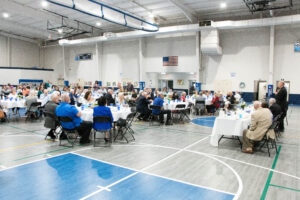
Bishop Mark Beckman speaks to the gathering at Eastview Recreation Center in Greeneville following the 70th-anniversary Mass at Notre Dame Church. (Photo Bill Brewer)
Notre Dame has had 27 priests in 70 years who have served either as pastor, associate pastor, or administrator. Mrs. Collins has known them all. Other longtime pastors include Father Charlie Burton from 1987 to 1992 and Father Jim Harvey, who served as an associate in 1996-97 and then as pastor from 1999 to 2006 and 2010-14.
“We’ve had wonderful priests,” Mrs. Collins said. “We’ve had priests who have cut down trees. We had three beautiful maple trees, and then one week they were gone. He gave them for firewood to somebody. He didn’t like the trees either because of all the leaves in his yard. Every priest has brought something different to the parish.”
Having frequent turnover in pastors is a good thing, Mrs. Collins observed.
“I think it’s wonderful that we change around like we do because we get to receive the gifts of so many different people, I have anyway in these 70 years,” she said. “I’ve heard sermons from so many different viewpoints, some people who are more concerned about the welfare of the community, others about the welfare of the building. You see all kinds, and you see that God calls all kinds of men, based on the needs of the diocese. The bishops always knew. We were sort of like the training church. After somebody got ordained, ‘you go to Greeneville.’ ‘You get ordained, you go to Greeneville.’ We’ve had a lot of young priests. I’ve been friends with all of them because as I said it’s a friendly, caring, giving community.”
Mr. Freimann’s gift in his will helped build the parish hall, Mrs. Collins recalled.
“That, along with money from the Extension Society,” she said.
The narthex and education wing followed, although not all of the buildings in Notre Dame’s plans were realized, Mrs. Collins said.
A former religious-education coordinator at Notre Dame, Mrs. Collins said there were more than 112 children enrolled at one time.
“Then it dwindled, and then there were no more kids because they were all grown up and teenagers and married, and then now we’re having all kids again, so it’s a living, vibrant church,” she said, pointing out Bishop Beckman’s comment about the crying baby and the church’s current configuration that does not include a cry room. “The bishop said something today about when you see kids, you know it’s a living church.
“You go to Mass, and we don’t have a cry room. I like hearing the crying because I know then that the mothers and daddies are bringing their kids to church. I used to go into the cry room when my kids were babies, and they played, and I was just trying to keep them entertained—I wasn’t really going to church as such. Cry rooms are nice for people who don’t like to hear the noise, but if you think about it, you’re in there with the angels and the saints and Jesus, and He loves the little children. He doesn’t want to lock them up in a cry room. Let them be.”
Mrs. Collins didn’t think she would stay and make her life in Greeneville during the early days of the parish.
“No, because nobody wanted to stay in Greeneville because it was just ‘a little hick town,’” she said. “I did go to the University of Tennessee in Knoxville, but I came home on weekends. I didn’t have a car. Had a bus that went back and forth between Knoxville and Greeneville. On weekends, you wanted to bring your friends home to your mom and dad so they could have home-cooked meals. I finished my education in three years because I took 24 hours a quarter so I could get finished. That was my first degree, in business.”
Employers back then, however, required a certain office skill from their female employees.
“I went to interview for a job, and they said, ‘Can you type?’ This was back in ’64. Nobody wanted a woman to do anything other than type, so I went back to school and got a degree to teach. I taught for 34 years, and that’s what God wanted me to do. He wanted me to be a teacher,” Mrs. Collins said. “I’ve been doing RCIA for over 25 years, and I look around at the people who are active in the church, and I’m thinking, ‘I helped you learn how much Jesus loves you and how you can share that love with others.’ And here they are coming up. It’s really neat.”
She enjoys RCIA as she has learned to let others take up many of the parish duties she always performed.
“I’ve been doing that for the past few years. I used to be the head of this and the head of that and the head of this, and I’m thinking, ‘OK, I’m getting old. You need to train other people to be the head of this and the head of that and the head of what-have-you.’ And God knew that my son was going to be disabled and be living at home, and He knew, too, that I needed to get everything squared away. I found wonderful ladies to head up the cooking. I used to do all the cooking—I was in charge of that. I’ve got a team of four ladies—they’re great. You just find different people that, when you ask them they say yes. You have to ask.”
Mrs. Collins never stops looking out for new people to join the Church, such as when she sees people go forward for a blessing during Communion, with their arms folded against their chest.
“I’ll go up afterward and say, ‘Sir, I notice that you go to Communion every Sunday, but you always do this [folds arms]. Are you Catholic?’ And if they say no, then I say, ‘Oh! I have a place for you.’ I’m real nosy,” she said with a laugh. “You don’t know how many people have come [into the Church] because I’ve said, ‘Are you Catholic?’”
Mrs. Collins’ husband, Jerry, is a retired musician who played trombone for artists including Frank Sinatra, Wayne Newton, and Cher, “All the biggies of our generation back in the ’70s and ’80s,” Mrs. Collins said. “He traveled worldwide.”
Jerry is Judy’s second husband and another she has influenced into coming into the Church.
“At my 30th high-school reunion, this young man comes from Las Vegas just to visit his mother and daddy, and we talk and go on a hike with my kids, and then the next thing I know we’re talking on the telephone every day back before telephone charges were cheap,” Mrs. Collins said. “That was in July, and that October he came to Greeneville, and we got married on my birthday. I got married in a non-Catholic wedding because he wasn’t Catholic. He moved to Greeneville and didn’t have a place to live, and we got married. He was working on an annulment, and when he got his annulment one year later, we got married in the Catholic Church.”
Jerry Collins took a little longer than some to move through RCIA into the Church.
“He came to church with me for something like eight to 10 years every Sunday,” Mrs. Collins said. “He tells people that he came because he wanted to be with me. I invited him to RCIA class. He came not one year, not two years, not three years, not four years—the fifth year he became Catholic. He’s the kind of person who thinks deep, and he wanted to be sure that he believed everything the Catholic Church taught. It is beautiful, and it made a difference in our lives.”

